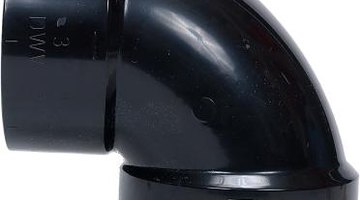Homemade PVC Chaise Lounge
Use lightweight, inexpensive PVC pipe and sturdy, weatherproof fabric to make a custom lounge chair. Choose a fabric to match your decor and alter the dimensions to suit your needs to enjoy the luxury of a chair that matches both the size of your body and style of your patio. You may use either "furniture-grade" pipe, which has a smooth finish or the less expensive PVC used for plumbing.

Step 1

Lay a 12-inch piece of PVC pipe on the ground. Place an L-shaped pipe fitting on each end so that the fittings are flat on the ground and the open ends point away from you. All piping used in this project is schedule 40 PVC pipe with a nominal inside diameter of 1 1/2 inches. Insert a 2-inch piece of pipe in the opening in each fitting so that the pipes point away from you.
Step 2
Attach a T-shaped fitting to the end of the 2-inch pipes so that the top bars of the "T's" are parallel to the pipe, and the bottoms of the "T's" point straight up. Insert two more 2-inch pieces of pipe in the openings in the connectors that point away from you. Attach a T-fitting to these pipes so that the top of the "T" is parallel to the pipe. Twist the fitting until the bottom of the "T" is pointing toward the center of the project. Insert a 12-inch pipe between the bottoms of these T-fittings. Insert a 2-inch pipe in the sides of these fittings that point away from you. You will have three 2-inch pieces of pipe in a straight line on each side. This rectangle is the base of the chair section of the chaise lounge.
Step 3
Place a T-fitting on the 2-inch pipe on the right side so that the top of the "T" is parallel to the pipe. Turn the fitting so that the bottom of the "T" points to the left. On the left pipe, place a 90-degree side outlet elbow fitting so that one opening points away from you, one opening points straight up and one opening points to the left.
Step 4
Insert 5-inch pipes in the two openings that point away from you. Place an L-fitting on the left pipe, with the opening in the fitting pointing toward the right. Place a T-fitting on the right pipe, with the top of the "T" parallel to the pipe. Turn the fitting so that the bottom of the "T" points to the left. Insert a 12-inch length of pipe between these two fittings to make the arm of the lounge. Place a 6-inch length of pipe in the remaining opening in the T-fitting on the right side, the opening that points away from you. Add an L-fitting to the other end of this pipe. Turn it so that the opening sticks straight up. The bar at the top of the back of the lounge will go in this opening.
Step 5
Add the top of the footrest by inserting a 24-inch length of pipe in the remaining opening in the 90-degree side outlet elbow, the opening that points left. Place a 90-degree side outlet elbow on the other end of the 24-inch pipe so that one opening points toward you and one opening points straight up. Place a 2-inch pipe in the opening that points toward you.
Step 6
Add a T-fitting to the end of the 2-inch pipe so that the top of the "T" is parallel to the pipe and the bottom of the "T" points straight up. Add another 2-inch pipe to the T-fitting so that the top of the "T" is parallel to both pipes. Place an L-fitting on the end of this pipe. Turn the L-fitting so the open end points straight up. This is one side of the chaise lounge.
Step 7
Make a mirror image of the first side for the second side. Insert 16-inch pipes in all the openings that stick straight up. Fit the other side on these pipes.
Step 8
Set the chaise right side up and turn all the joints until they are square. Draw a pencil line across each joint, parallel to the pipe. These lines will help you construct the chair when you cement it together.
Step 9
Cut an 18-inch-wide, 64-inch-long rectangle of weatherproof fabric. Fold in 3/8 of an inch on the long edges then another 5/8 of an inch. Sew between the folds to make a narrow hem.
Step 10
Make casing for the ends of the cover by making a 1/2-inch fold on the short edges, then folding down 2 1/2 inches. Sew 1/4 inch from the inside fold to hold the casing in place.
Step 11
Cement the sides of the chair together by swabbing PVC glue on the inside of each joint and inserting the pipe. Twist the pipe a quarter turn to spread the glue, then carefully align the pencil lines.
Step 12
Lay one side down, with the remaining openings in the fittings facing up. Glue the pipes in these fittings. Thread one casing of the fabric cover onto the bar at the top of the back of the chair. Thread the casing on the other end of the cover onto the top bar at the end of the footrest. Turn the other side of the chair so that the openings in the fittings point down. Insert the pipes into these fittings and cement them in place.
Tips
- Cut PVC pipe by placing it in a miter bow and sawing straight across with a hacksaw.
Writer Bio
Camela Bryan's first published article appeared in "Welcome Home" magazine in 1993. She wrote and published SAT preparation worksheets and is also a professional seamstress who has worked for a children's theater as a costume designer and in her own heirloom-sewing business. Bryan has a Bachelor of Science in chemical engineering from the University of Florida.
Photo Credits
- Jupiterimages/Photos.com/Getty Images
- Zedcor Wholly Owned/PhotoObjects.net/Getty Images
More Articles



